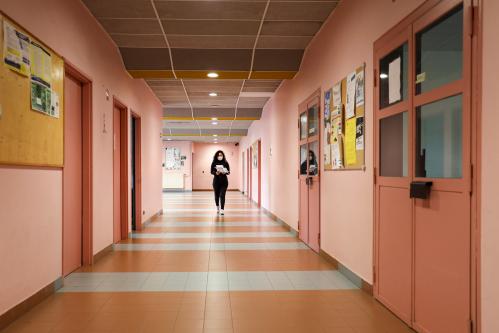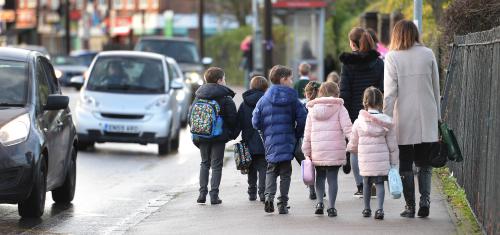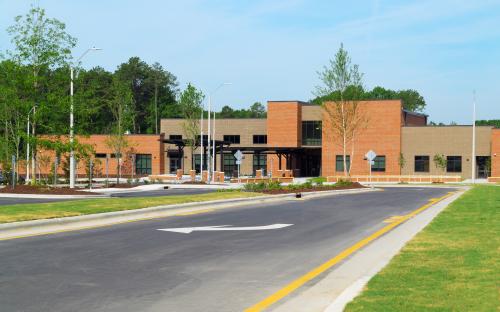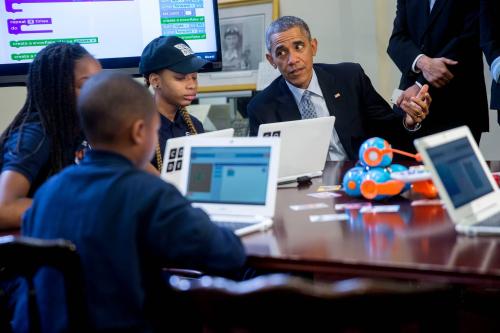Throughout the first year of his presidency, Joe Biden has regularly highlighted the need for investing in school infrastructure. From speeches referencing the lack of safe drinking water and ventilation to the pollution produced by school buses, the subject has been consistently present in the administration’s remarks. The American Society of Civil Engineers echoed these concerns in its release of the nation’s infrastructure report card earlier this year, grading public school facilities with a D+.
This post describes recent developments in the administration’s school infrastructure proposals, highlights areas of underinvestment, and summarizes recent research on how some of these failings might impact students.
On Nov. 15, 2021, President Biden signed the Infrastructure Investment and Jobs Act into law, with total investments of $1.2 trillion over 10 years (including $550 billion in new spending). The package covers $284 billion in new funds directed toward transportation needs, such as roads, bridges, public transport, railroads, and electric vehicles. The remaining $266 billion in new investments focus on core infrastructure—ranging from improving the power grid, broadband access, and water systems to environmental resiliency and remediation.
But there is one notable category that is missing in the newly minted infrastructure legislation: schools.
In early versions of Biden’s infrastructure plan, the White House outlined a $100 billion investment for “school construction and modernization.” In September 2021, the proposed investment slipped to $82 billion; by late October, all language referencing school investment was removed from the plan. This left many educators, families, and advocates who were previously hopeful about the potential investment disappointed—especially those suffering from the consequences of failing and dangerous school infrastructure.
Reviewing the lack of infrastructure investment
Maintenance on existing school buildings is inadequate in many communities nationwide. The Government Accountability Office (GAO) reports that 53% of school districts said that they need to replace multiple building systems (HVAC, electric, plumbing, gas piping, fire protection, etc.), while 16% of districts have not assessed their building needs in more than 10 years. According to the Center for Budget and Policy Priorities, the most recent comprehensive estimate by the Department of Education, from 2014, found that $197 billion would be needed to improve school facilities to a level considered “good.” Dwindling school spending since the Great Recession implies that number might be an underestimate. More recent estimates indicate that $85 billion per year is needed to maintain “good stewardship” of our nation’s schools.
The 21st Century School Fund calculated that districts fund 81% of their capital expenditures with local moneys, with states covering the remaining 19%. This raises obvious equity concerns. Districts and states with higher concentrations of low-income communities may struggle to levy funds for long-term investments, resulting in stocks of poorly maintained facilities and few resources for new ones. Kenneth Shores, Hojung Lee, and Nell Williams examined the sources driving funding inequities (overall, not just infrastructure related), and they concluded that the major gaps in per-pupil spending arise across states, though inequities within states and districts also exist. The previously cited GAO report points out that high-poverty districts spent $300 (30%) less per student than their more affluent counterparts on expenditures for capital construction. This piles more difficulties onto the already full plate of challenges that high-need districts face.
It is important to acknowledge that approximately $190 billion in funds have been made available for districts and states through 2020 and 2021 from Elementary and Secondary School Emergency Relief (ESSER) funding to stabilize school spending in the face of the pandemic. But many of these funds are directed to critical pandemic-induced challenges, such as learning loss and protective equipment. Though the Department of Education allows the use of ESSER funds for some infrastructure investments (such as HVAC systems), potentially billions of dollars in school capital needs are left unaddressed.
Why the condition of school facilities matters for students
A growing body of research indicates that underinvestment in school infrastructure negatively impacts not only the health of K-12 students but also their educational outcomes. For example, researchers analyzed data from a district in Texas and found that students attending schools in disrepair or with understaffed maintenance teams had lower levels of attendance and higher dropout rates. Claudia Persico has shown in successive studies that poor air quality, antiquated HVAC systems, and geographic proximity to Toxic Release Inventory (TRI) sites can negatively impact the safety of schoolchildren. The findings highlight that the physical location of schools and the consequent exposure of students to pollutants also negatively impact student test scores and increase absences and suspensions. Meanwhile, other research suggests that improving filtration systems can decrease the risk of illness and potentially increase student achievement.
Not all improvements to school facilities must necessarily be costly investments. Thousands of schoolchildren ride in diesel-fueled buses to and from school, which are not only ecologically harmful but cause direct health and academic harm to students. This situation can be mitigated by modifying school bus engines with cheap filters to curtail pollutants. An investigation into the impact of these adaptations significantly improved the academic performance of students.
Just as poor infrastructure negatively impacts students, facilities in good condition can promote an adequate learning environment. Researchers studied the effects of new infrastructure on educational achievement in Los Angeles, concluding that spending four years in a new school building is associated with increased math and English test scores. A study from Michigan examined bond referenda and found positive long-run effects of investments in school infrastructure on student reading proficiency levels.
Researchers from the Harvard School of Public Health recently reviewed this literature, writing: “There is overwhelming evidence for researchers, legislators, designers, parents, teachers, school districts, and community members to make compelling, fact-based arguments for elevating the role of the school building in the national conversation on education.”
America’s public investment in school infrastructure is lagging, and harming students as a result—especially in historically underserved areas. With schools overlooked in the recent infrastructure package and negotiations surrounding Biden’s Build Back Better plan stalled, it may be on local and state leaders—along with other stakeholders—to address these needs.








Commentary
Federal investments ignore crucial upgrades to school facilities—and students pay the price
January 21, 2022